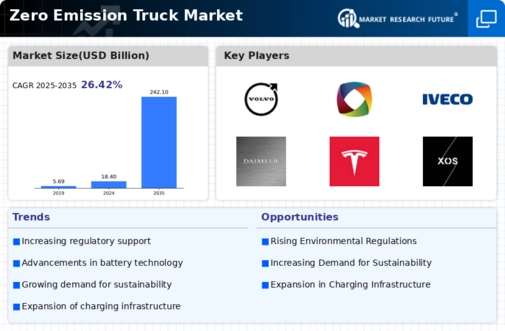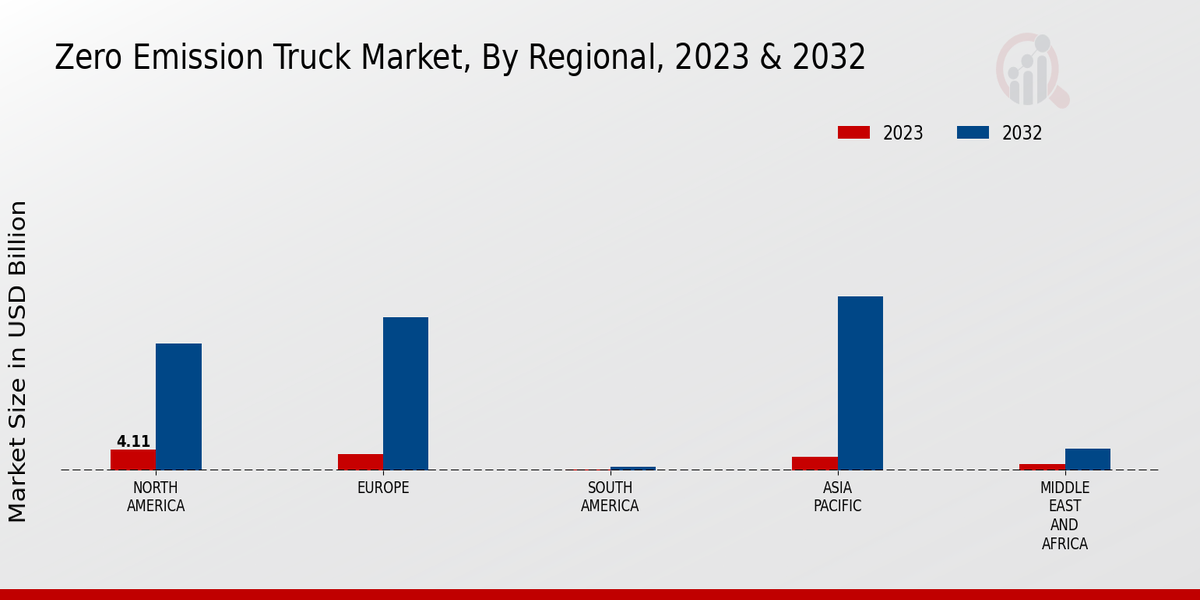Rising Fuel Costs
The volatility of fuel prices is a critical factor influencing the Global Zero Emission Truck Market Industry. As traditional fuel costs continue to fluctuate, fleet operators are increasingly considering the long-term economic benefits of switching to zero-emission trucks. Electric and hydrogen-powered vehicles offer lower operational costs compared to their diesel counterparts, particularly in terms of fuel and maintenance expenses. This economic rationale is likely to accelerate the adoption of zero-emission trucks, as companies seek to mitigate the impact of rising fuel costs on their bottom line. The market is poised for substantial growth as these economic factors come into play.
Market Growth Projections
The Global Zero Emission Truck Market Industry is projected to experience substantial growth, with estimates indicating a rise from 18.4 USD Billion in 2024 to 242.1 USD Billion by 2035. This remarkable growth trajectory suggests a burgeoning demand for zero-emission trucks, driven by various factors including regulatory support, technological advancements, and increasing environmental awareness. The anticipated compound annual growth rate of 26.42% from 2025 to 2035 further underscores the market's potential. Such projections highlight the evolving landscape of the transportation sector, where zero-emission solutions are becoming increasingly viable and necessary.
Infrastructure Development
The expansion of charging and refueling infrastructure is essential for the growth of the Global Zero Emission Truck Market Industry. Governments and private entities are investing in the development of comprehensive networks for electric and hydrogen refueling stations. This infrastructure is crucial for alleviating range anxiety among fleet operators and ensuring the practicality of zero-emission trucks. As infrastructure improves, the adoption rate of these vehicles is expected to rise, further propelling market growth. The Global Zero Emission Truck Market is anticipated to experience significant advancements as infrastructure development continues to evolve.
Technological Advancements
Technological innovations play a pivotal role in the Global Zero Emission Truck Market Industry, driving efficiency and performance improvements. Advances in battery technology, such as solid-state batteries, are enhancing the range and reducing charging times for electric trucks. Moreover, developments in hydrogen fuel cell technology are expanding the options available for zero-emission heavy-duty vehicles. These innovations are likely to attract more fleet operators to adopt zero-emission trucks, thereby contributing to market growth. As the industry evolves, the Global Zero Emission Truck Market could witness a compound annual growth rate of 26.42% from 2025 to 2035.
Growing Environmental Awareness
Increasing environmental consciousness among consumers and businesses is propelling the Global Zero Emission Truck Market Industry. Companies are increasingly recognizing the importance of sustainability in their operations, leading to a shift towards greener logistics solutions. This trend is evident in the logistics sector, where major players are committing to carbon neutrality and investing in zero-emission fleets. The heightened focus on sustainability is likely to drive demand for zero-emission trucks, as businesses seek to align their operations with environmental goals. This shift is expected to significantly influence market dynamics in the coming years.
Regulatory Support and Incentives
The Global Zero Emission Truck Market Industry benefits from robust regulatory frameworks and government incentives aimed at reducing greenhouse gas emissions. Various countries are implementing stringent emission standards, which compel manufacturers to innovate and produce zero-emission vehicles. For instance, the European Union has set ambitious targets for reducing carbon emissions from heavy-duty vehicles. This regulatory environment not only encourages investment in zero-emission technologies but also enhances market growth. The Global Zero Emission Truck Market is projected to reach 18.4 USD Billion in 2024, reflecting the impact of these supportive policies.













